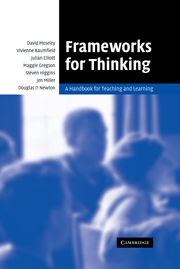Book contents
- Frontmatter
- Contents
- List of figures
- List of tables
- Notes on authors
- Foreword
- Acknowledgments
- Introduction
- 1 The nature of thinking and thinking skills
- 2 Lists, inventories, groups, taxonomies and frameworks
- 3 Frameworks dealing with instructional design
- 4 Frameworks dealing with productive thinking
- 5 Frameworks dealing with cognitive structure and/or development
- 6 Seven ‘all-embracing’ frameworks
- 7 Moving from understanding to productive thinking: implications for practice
- References
- Index
Foreword
Published online by Cambridge University Press: 22 September 2009
- Frontmatter
- Contents
- List of figures
- List of tables
- Notes on authors
- Foreword
- Acknowledgments
- Introduction
- 1 The nature of thinking and thinking skills
- 2 Lists, inventories, groups, taxonomies and frameworks
- 3 Frameworks dealing with instructional design
- 4 Frameworks dealing with productive thinking
- 5 Frameworks dealing with cognitive structure and/or development
- 6 Seven ‘all-embracing’ frameworks
- 7 Moving from understanding to productive thinking: implications for practice
- References
- Index
Summary
I have two reproductions of great art on my desk. One is an inexpensive copy of Auguste Rodin's imponderable masterpiece, the Thinker, hunched over in his familiar pose that portrays ‘every man’ who is ‘lost in thought’. The other ‘objet d'art’ is an inflatable replica of Edvard Munch's depiction of mental anguish in his renowned painting ‘The Scream’. As I think about the task of integrating and classifying the last 50 years of theory and research in critical thinking, these two images come to mind and merge. In my mind's eye, I can see Rodin's inscrutable Thinker contort his face into that of the one depicted in ‘The Scream’ when the thoughtful, and presumably silent, Thinker is faced with organising and evaluating the literature on thinking skills. Fortunately, for those of us who care about improving how students think, we can all save our voices from the possible harm caused by a shrill scream because of the excellent work toward creating an organising taxonomy of thinking skills presented in Frameworks for Thinking : A Handbook for Teaching and Learning.
David Moseley and his able band of co-authors have boldly sorted through a mountain of literature to create a thinking skills taxonomy, so that we can identify what, when, and how well different methods and theories work to develop students' critical thinking abilities.
- Type
- Chapter
- Information
- Frameworks for ThinkingA Handbook for Teaching and Learning, pp. xv - xviPublisher: Cambridge University PressPrint publication year: 2005



